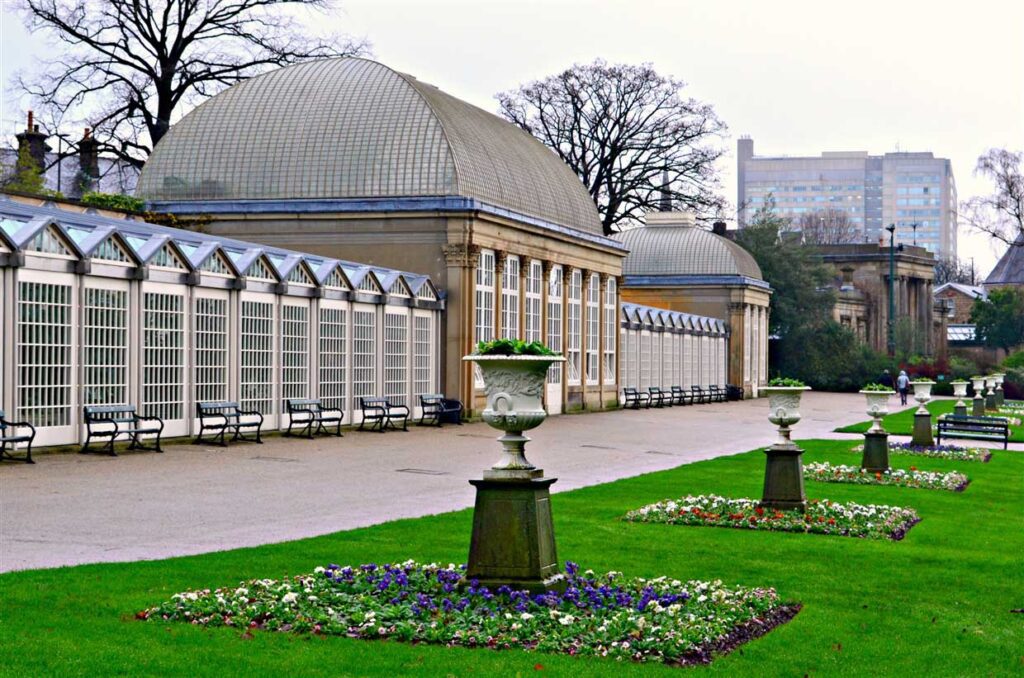Botanical gardens set out 1834-6 by Robert Marnock with modern conservatories by B Taylor.

DESCRIPTION
The Botanical Gardens are positioned approximately 2km south-west of Sheffield city centre in a residential area. The site is on land which slopes to the south-east towards Sharrow Vale as well as the borders are formed by Clarkehouse Roadway to the north, Organic Roadway to the west, yards backing from Wigfull Roadway and Thompson Road to the south, as well as gardens backing from Southgrove Road to the eastern. The borders are typically walled and those parts dividing the site from roads have actually walls with railings.
ENTRANCES
The main entry is at the north-east corner of the website from Clarkehouse Roadway where there is a classical portal with lodges and also a screen wall surface (detailed quality II) created by B Taylor c 1836. Additional entryways are situated at the north end of Agricultural Roadway on the west side of the site where there is an iron-caged turnstile (provided grade II with the entrance and also screen wall surfaces) as well as on Thompson Roadway at the south-east suggestion of the website, where there is a gateway flanked by a low wall surmounted by railings (c 1900, detailed quality II). Some 100m north of this entrance there is a Gothic Revival-style lodge (very early C19, noted grade II).
MAIN STRUCTURE
The focus of the Gardens is a variety of three sunrooms of 1837( 8 designed by B Taylor (each provided grade II *) which were connected by glazed pathways as shown on a picture of c 1890 (Sheffield CC 1996). The pathways had been gotten rid of by the time a photograph of c 1910 was taken (ibid). A concrete pillars of c 1935 links the eastern as well as central conservatories. The sunrooms were based on the design of Paxton’s glasshouses at Chatsworth and are referred to as the ‘Paxton Pavilions’ in C19 and also C20 descriptions of the Gardens. They were heated up and the main sunroom, referred to as the Palm Residence, was flanked by warm homes. The western pavilion housed a locally popular instance of the Victoria Regia waterlily throughout the later part of the C19.
GARDENS AND GROUNDS
The Gardens contain a formal core bordered by informal locations with winding paths.<br>
A boardwalk leaves the front of the conservatories which are positioned at the north end of the site, at its highest point, overlooking falling land to the south-east with views throughout the valley. Marnock mentioned this sight in an article of 1836 (Floricultural Mag) in which he explains the ‘lovely sweep of rental property landscape for which the western precincts of Sheffield are deservedly commemorated’. A course flanked by lawns leads south from the main sunroom to a Crimean War Memorial (listed grade II), c 120m to the south, which ends the vista. This was offered the website from in other places in Sheffield in 1960 changing a circular swimming pool with a water fountain which is shown on the 1851 OS map as well as on an engraving of 1836 (ibid).
On the west side of the yards, c 100m south-west of the conservatories, there is a rose garden confined by clipped yew hedges on the site of formal gardens revealed on the 1851 OS map.<br>
A system of curving paths leads around the site in a pattern which adapts closely with that revealed on the 1851 OS map. From the Clarkehouse Roadway entry a course branches westwards leading behind (to the north of) the conservatories through woodland, transforming southwards over dropping land as the site’s perimeter is adhered to. Paths lead off right into the gardens and also some stretches have rock actions leading down the slope. A Bear Pit (early C19, noted grade II) is located in the timberland c 120m south-west of the sunrooms. This is a round pit naturally rubble penetrated the slope of the land which is entered from the south-east using a three-way curved entryway. There are grassed clearings up to the north and also south of the Bear Pit. The south-west and south parts of the gardens normally include areas of forest with clearings up planted with specimen trees as well as bushes, high as shown on the 1851 OS map. The land drops steeply southern of the Battle Memorial from which actions lead down to accompany courses via this part of the site. A description of 1836 (ibid) states fish ponds, rustic bridges and also archways in this area which are shown on the 1851 OS map but have now (1997) largely disappeared.
The eastern side of the website is extra open in character. Some 100m south-east of the sunrooms there is a rock yard, probably of very early C20 date, with a waterfall at its north end feeding a slim swimming pool. East of this there is a location called Osborne Field which is separated from the Gardens by a fencing, and also instantly southern of this the Robert Marnock Yard is also fenced. Both areas are outside the boundary of the Gardens as shown on the 1851 OS map, and were added throughout the late C20. Paths lead south to the Thompson Road entry and also there is a grass called Bottom Lawn c 50m south-east of the Battle Memorial with beds and also sampling trees and also shrubs.
On the south-east side of the website baby rooms and upkeep areas are divided from the Gardens by beech bushes as well as fencing. These are on the site of baby rooms shown on the 1851 OS map. Glasshouses revealed on the 1890 OS map have been changed by late C20 frameworks.
